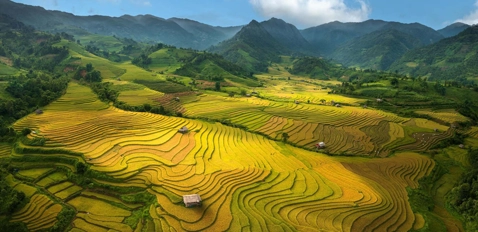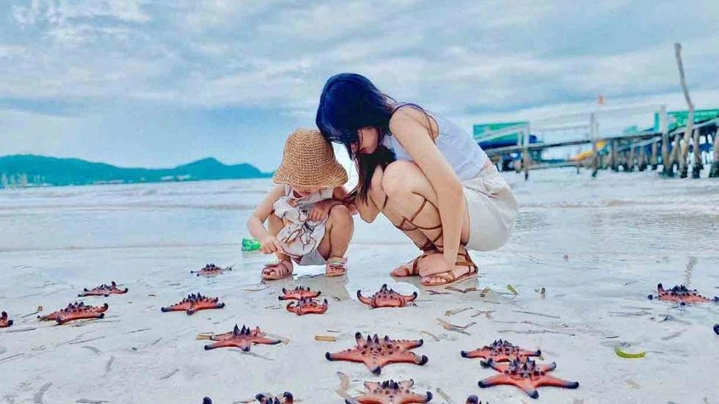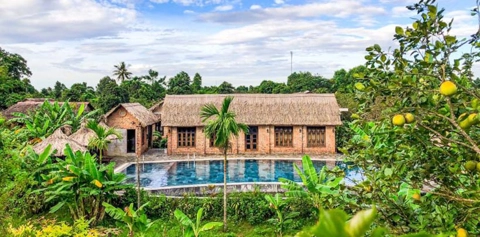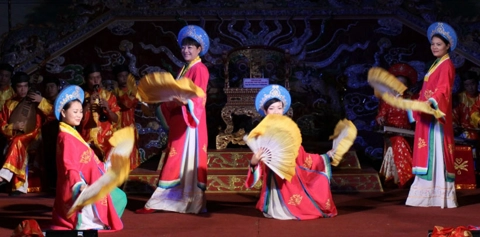Map Of Hue: Savor The Soul of Vietnam’s Ancient Capital
Hue is one of Vietnam’s most famous tourist destinations, attracting numerous visitors with its long-standing imperial culture, rich historical value, artistic heritage, unique architecture, and exceptional cuisine.
Geography & Administrative Divisions
Hue is a province located on the central coast of Vietnam, bordering Laos, the East Sea, Quang Nam, Da Nang, and Quang Tri. It is renowned for its poetic, peaceful, and gentle beauty—a charm that inspires many to visit at least once in their lifetime.
The ancient capital of Hue served as Vietnam’s imperial seat under the Nguyen Dynasty from 1802 to 1945. The Complex of Hue Monuments—including the Imperial City, Citadel, Forbidden Purple City, and royal tombs—has been recognized by UNESCO as a World Cultural Heritage Site.
A journey to the former capital allows visitors to admire golden palaces, solemn mausoleums, and historical landscapes steeped in heritage. All of these elements contribute to the unique charm of Hue. Plan a trip to Hue to witness and experience both tangible and intangible cultural heritages that reflect the intellectual and spiritual values of the Vietnamese people.
Here are some key geographical and administrative facts about Hue:
Total area: approximately 5,053 km²
Population: around 1.1 million people (as of the latest census)
Topography: diverse landscape with mountains in the west, plains in the center, and a long coastline along the East Sea
Borders: shares boundaries with Quang Tri, Quang Nam, Da Nang, Laos, and the East Sea
Region: North Central Coast of Vietnam
Administratively, Hue includes:
1 provincial city: Hue City (provincial capital)
8 districts: Phong Dien, Quang Dien, Huong Tra (town), Huong Thuy (town), Phu Vang, Phu Loc, Nam Dong, and A Luoi
Climate & Best Time To Visit
Located in Central Vietnam, Hue has a tropical monsoon climate characterized by two distinct seasons. The dry season, from March to August, is marked by warm temperatures, abundant sunshine, and relatively low humidity. Meanwhile, the rainy season lasts from September to February, bringing frequent showers, overcast skies, and cooler air, especially during late autumn and winter.
January–February: This time of year is a transitional period when winter gradually gives way to spring. The weather is mild, the cold starts to fade, and warm sunshine returns. This is a wonderful time to enjoy the vibrant blooms and peaceful atmosphere of spring in Hue.
April (Festival Season): April is one of the liveliest times in Hue, especially during the Hue Festival, usually held at the end of the month. This cultural event features traditional performances, artistic displays, and a wide range of entertainment activities that honor Hue’s heritage and boost local tourism.
May–September (Best Time for Sightseeing & Beach Activities): These months bring dry, sunny days, making them perfect for exploring famous landmarks, relaxing at the beach, and joining exciting outdoor experiences.
You can visit Hue any time of the year, as each season unveils a unique charm. Whether you prefer colorful springtime streets, vibrant cultural festivals, or warm sunny days, Hue has something special to offer all year round.
Top Attractions In Hue
Historical And Cultural Landmarks
Imperial City of Hue
The Imperial City of Hue is part of the Complex of Hue Monuments, recognized by UNESCO as a World Cultural Heritage Site in 1993. This vast architectural ensemble features over 100 structures, including the Noon Gate (Ngo Mon), Thai Hoa Palace, the Forbidden Purple City, Dien Tho Palace, and more—each reflecting the rich history and feudal culture of Vietnam. Visiting the Imperial City, you’ll be immersed in majestic ancient architecture and gain insights into the royal life of the Nguyen Dynasty.
Tomb of Tu Duc
Tu Duc Tomb (also known as Khiem Tomb) is nestled in a narrow valley in Thuong Ba Village, Hue City. It is the final resting place of Emperor Tu Duc, the fourth ruler of the Nguyen Dynasty. Regarded as one of the most beautiful royal mausoleums in Hue, Tu Duc Tomb is renowned for its poetic and serene atmosphere, featuring tranquil lakes, lush greenery, and unique architectural structures.
Tomb of Khai Dinh
Khai Dinh Tomb (also known as Ung Tomb) is located on Chau Chu Mountain, about 10 kilometers from Hue city center. It is the resting place of Emperor Khai Dinh, the 12th ruler of the Nguyen Dynasty. This tomb stands out for its unique architecture, which harmoniously blends traditional Vietnamese art with Western influences. Here, visitors can admire intricate bas-reliefs crafted from porcelain, ceramics, and colored glass, along with other grand architectural structures.
Tomb of Minh Mang
Minh Mang Tomb (also known as Hieu Tomb) is the final resting place of Emperor Minh Mang, the second ruler of the Nguyen Dynasty. Located on Cam Khe Mountain in Huong Tho Commune, about 14 kilometers southwest of Hue city center, this tomb is one of the most beautiful and grandiose imperial mausoleums. It comprises over 40 architectural structures of varying sizes. The tomb’s design reflects strong Confucian principles, showcasing solemnity, symmetry, and majesty.
An Dinh Palace
An Dinh Palace is located on the banks of the An Cuu River in Hue City. It served as the private residence of Emperor Khai Dinh from his days as a crown prince until his reign, and was later inherited by Emperor Bao Dai, who lived here after his abdication. The palace is a harmonious blend of Eastern and Western architectural styles, impressing visitors with its intricate decorative details and elaborate patterns. Surrounded by a spacious garden with lush greenery and serene ponds, An Dinh Palace offers a picturesque and tranquil setting.
An Hien Garden House
Dubbed “the most beautiful garden house in Hue,” An Hien Garden House is a year-round destination for visitors from near and far. Located on the northern bank of the Huong River, along the road leading to Thien Mu Pagoda, An Hien covers nearly 5,000 square meters. It is designed in the traditional Hue ruong house style and uniquely blends this with a fruit garden that bears produce throughout the year.
With a history spanning over a century, An Hien Garden House has remarkably preserved the scenic beauty and architectural essence of the old Hue garden house. It reflects both the elegance of the aristocracy and the charm of traditional folk culture.
Hue National Academy
Located by the Huong River, the red-painted building of Quoc Hoc High School stands out as a striking landmark in the dreamy city of Hue. Established during the reign of Emperor Thanh Thai in 1896, the school covers an area of 4,237 m². It was the first French–Vietnamese high school in all of Indochina and the first secondary school in Hue. Visitors can take beautiful photos along its corridors, in the schoolyard, on stone benches, or under the brilliant red flamboyant trees.
Sacred Religious Sites
Thien Mu Pagoda
A must-see landmark on any journey to Hue, Thien Mu Pagoda dates back to the 1600s and has been preserved through numerous restorations. The pagoda captivates visitors with its majestic, grand architecture while maintaining a peaceful and poetic atmosphere. To reach Thien Mu Pagoda, you can take a romantic boat ride along the Huong River.
Hon Chen Temple
Facing the Huong River and nestled under lush trees, Hon Chen Temple holds a significant place in the spiritual life of Hue’s people. It is the only temple in Hue that blends royal rituals with folk beliefs. The temple also showcases artistic decoration that reached its peak in the late 19th century.
Bach Ma Zen Monastery
About 30 km from the city center, you’ll reach the Truoi region. From there, head toward the Truoi Dam and follow the gentle slope along the hillside to find Truc Lam Bach Ma Zen Monastery reflected in the peaceful waters of Truoi Lake. A small boat ride across the lake will take you to the monastery. To reach the triple-arched gate, visitors must climb 172 steps. The monastery’s architecture harmoniously blends with the surrounding mountains and water, with the main hall featuring a statue of the Buddha meditating beneath a bodhi tree.
Tu Dam Pagoda
Tu Dam Pagoda was originally named An Ton and was founded by Zen master Minh Hoang Tu Dung around the year 1695. The pagoda is widely known for its significant role in the revival and development of Vietnamese Buddhism in the modern era. Today, Tu Dam is not only a spiritual landmark but also a popular destination on the list of must-visit sites in Hue.
Bao Quoc Pagoda
Bao Quoc Pagoda is located on Bao Quoc Street in Phuong Duc Ward, Hue. Built in the traditional “Khau” (口) architectural style, the pagoda is home to many stupas of revered Buddhist patriarchs. It is also famous for the mysterious legends surrounding the Ham Long Well. Today, Bao Quoc Pagoda attracts numerous visitors who come to admire its peaceful beauty and pray for peace and blessings.
Natural Scenery & Romantic Landscapes
Huong River
If asked which tourist destination in Hue has left a deep impression in literature and poetry, the answer would undoubtedly be the Huong River. This iconic attraction of Hue has inspired countless literary works, embodying a poetic and romantic beauty that captivates every visitor. Stretching over 30 kilometers, the river is considered a priceless gift from nature to this land.
Vong Canh Hill
Vong Canh Hill in Hue is considered the best place to watch the sunset in the city. Here, mountains, skies, rivers, and greenery blend harmoniously to create a dreamy, romantic landscape. Visitors often come to camp, enjoy the scenery, and breathe in the fresh air to escape the worries of everyday life
Lang Co Bay
Lang Co Bay in Hue is an ideal destination for those who love romantic and peaceful scenery. Known as one of the most beautiful bays in the world, it features long stretches of smooth white sand and crystal-clear, refreshing waters. Visitors can watch the stunning sunrise over Canh Duong Beach, explore Bach Ma Mountain, admire the beauty of Lang Co Bay, and enjoy exciting activities such as fishing, camping, and outdoor fun.
Ngu Binh Mountain
With its majestic natural landscape, highlighted by lush pine forests, Ngu Binh mountain offers visitors a chance to fully enjoy the vast mountain scenery and the fresh, tranquil atmosphere of the highlands. It also provides a perfect vantage point to admire the full beauty of the poetic Huong River. This was once a popular picnic spot for the Nguyen Dynasty kings.
Tam Giang Lagoon
Tam Giang Lagoon is part of the Tam Giang–Cau Hai lagoon system, renowned as the largest brackish water lagoon in Southeast Asia. Covering an area of about 52 square kilometers and stretching approximately 24 kilometers from the O Lau River estuary to the Huong River mouth, this destination captivates countless visitors with the untouched beauty of ancient fishing villages and the enchanting scenery of seafood farms bathed in sunset hues.
Thuan An Beach
Thuan An Beach in Hue captivates visitors with its crystal-clear water, smooth white sand, and pristine natural charm. The best time to visit is early in the morning, when you can witness the lively scene of fishing boats returning with a fresh catch. It’s also the perfect time to savor delicious seafood dishes freshly brought in by local fishermen.
Bach Ma National Park
Located about 40 kilometers from Hue city, Bach Ma National Park is a must-visit destination, especially for nature lovers and adventure seekers. Here, visitors can trek to the summit of Bach Ma Mountain, where they’ll be rewarded with panoramic views of endless mountain ranges and a breathtaking natural landscape rarely found elsewhere. The park is home to a remarkably diverse ecosystem with 2,147 species of flora and fauna. Its untouched beauty and tranquil atmosphere—especially on misty days when clouds drift gently over the forest—create an enchanting experience.
Entertainment & Leisure Activities
Hue Walking Street
Hue Walking Street is a vibrant destination that draws many visitors with its lively atmosphere and rich cultural charm. Open from 6:00 PM to 11:00 PM every Friday, Saturday, and Sunday, this bustling area is perfect for enjoying iconic local street food, watching unique street performances, and soaking in the festive spirit. It promises fun and relaxing moments for all.
Dong Ba Market
Dong Ba Market is one of Hue’s most bustling and vibrant tourist destinations. As the largest market in the city, it offers a wide variety of goods across numerous stalls. The market features a three-story building known as the “Bell Tower.” The first floor is dedicated to dried seafood and Hue’s signature fermented specialties; the second floor showcases handicrafts and souvenirs; while the third floor houses fabric and clothing stalls.
Songlab Digital Art Centre
Songlab Digital Art Center is a unique and modern attraction in Hue, where technology meets art. Visitors can immerse themselves in captivating digital artworks, interact with virtual spaces, and explore the latest applications of technology in contemporary art.
Lim Hue Wooden Bridge
Hue Wooden Bridge, also known as the Hue Walking Bridge, stretches across the poetic Huong River, connecting Nguyen Dinh Chieu pedestrian street with Ly Tu Trong Park. Inaugurated in 2018, it quickly became one of Hue’s most popular tourist spots. This wooden bridge offers an ideal place for a leisurely walk, scenic views of the river, and great photo opportunities.
Cuisine & Local Specialties
Hue is a true culinary gem of Vietnam, known for its delicate flavors, royal-inspired recipes, and visually stunning dishes. Some must-try specialties include:
Bun Bo Hue: A rich, spicy beef noodle soup with lemongrass, chili oil, pork knuckles, and beef shank, often served with herbs and lime.
Steamed Rice Discs with Shrimp (Banh beo): Soft steamed rice cakes topped with minced shrimp, crispy pork skin, and scallion oil, typically served in small dishes with dipping sauce.
Flat Steamed Rice Dumplings (Banh nam): Delicate, flat dumplings made from rice flour, filled with minced shrimp and pork, wrapped in banana leaves, and steamed until fragrant.
Clear Tapioca Dumplings (Banh loc): Translucent, chewy tapioca dumplings stuffed with shrimp and pork belly, served with sweet-savory fish sauce and wrapped in banana leaves.
Grilled Pork Skewers (Nem lui): Flavorful pork skewers grilled on lemongrass sticks, served with rice paper, herbs, pickles, and dipping sauce for rolling.
Fig Salad (Va tron) A light and refreshing salad made from thinly sliced young figs, mixed with shrimp or pork, herbs, and roasted peanuts.
Clam Rice (Com hen): A humble yet tasty dish of rice topped with sautéed baby clams, herbs, pork rinds, peanuts, and a dash of shrimp paste.
Hue Sizzling Pancake (Banh khoai): Crispy rice flour pancake stuffed with shrimp, pork, and bean sprouts, served with fresh vegetables and fermented soybean dipping sauce.
Hue Sweet Soup (Che Hue): An assorted mix of sweet soups featuring beans, fruits, and jelly, often layered in a glass for a colorful, refreshing dessert.
Fried Sticky Rice Dumplings (Banh ram it): A unique dish combining a crunchy fried rice base and a chewy glutinous rice dumpling, filled with shrimp and pork.
Want to explore these dishes in detail? Check out our full guide to Hue cuisine here—packed with mouthwatering photos, local insights, and where to try each dish.
Hue’s Living Heritage: People, Festivals, Arts, And Traditional Crafts
People of Hue—Graceful and Rich in Cultural Identity
The people of Hue are the living embodiment of the ancient capital’s culture—graceful, gentle, and full of charm. Their soft, sweet, and endearing accent leaves an unforgettable impression on visitors. From the tender “dạ” and “thưa” to their courteous mannerisms, Hue locals exude modesty, hospitality, and a deep respect for tradition. Especially iconic is the image of Hue women in purple ao dai and conical hats adorned with poetic verses, symbolizing a delicate and timeless beauty that is hard to find elsewhere. It is this inner elegance and refined lifestyle that create Hue’s unique identity, leaving a lasting mark in the hearts of all who visit.
Festivals In Hue—Celebrating Tradition & Culture
Hue is a city rich in festivals that embody traditional regional colors and cultural depth. These events create a vibrant cultural tapestry that leaves lasting impressions on visitors.
Hue Festival (biennial): A major international cultural showcase featuring royal music, kite flying, Ao Dai fashion parades, street art, poetry recitals, and traditional rituals, including the Nam Giao offering ceremony at the Imperial Esplanade.
Ao Dai Festival: Part of the Hue Festival and celebrated with nationwide designers and model parades in traditional and modern ao dai.
Hon Chen Temple Festival: Held twice annually in the 3rd and 7th lunar months, featuring a solemn procession of the Holy Mother Thien Y A Na on decorated boats along the Huong River.
Sinh Village Wrestling Festival: Takes place around the 10th of the first lunar month in Lai An, where locals and visitors watch energetic traditional wrestling matches symbolizing strength and community spirit.
Cau Ngu Festival (Fish Worship Festival): Held around the 12th lunar day, with ritual performances and boat racing celebrating the wish for safe fishing and abundant harvests.
Boat Racing Festival: Organized on National Day (Sept 2) along the Huong River, this popular competition showcases rowing teams and draws enthusiastic crowds.
Bai Choi Festival: A Tet-time folk art combining singing, improvisation, and game performance under bamboo huts—a cultural signature of central Vietnam.
Arts in Hue—A Living Legacy Of The Imperial City
Hue’s artistic heritage is a vivid reflection of its imperial past and rich cultural identity. From traditional court music to theatrical performances and lyrical folk songs, art in Hue has always been a refined, sacred expression of both the royal and the common
.
Tuong
Developed during the 17th century under the Nguyen Lords and later elevated to national drama by the Nguyen Dynasty, tuong (classical opera) flourished with royal patronage. Emperors Minh Mang and Tu Duc supported its institutionalization by establishing training centers. Today, visitors can admire this tradition at the Duyet Thi Duong Theater inside the Imperial City. Classic plays such as Son Hau, Duong Chan Tu, and Tam nu do vuong are still performed, preserving the elegance and depth of this once-royal art form.
Ca Hue on the Huong River
A cherished cultural treasure of the city, Ca Hue blends folk and royal music traditions into heartfelt lyrical performances. With a deep sense of nostalgia and emotion, these ballads are performed aboard dragon boats drifting along the Huong River. Accompanied by traditional instruments like the tranh, ty, nguyet, sao, … This intimate musical experience brings you closer to the soul of Hue. It is a poetic journey that captures the serene spirit of the city’s people and landscapes.
Nha Nhac
Nha nhac, or “elegant music,” is the ceremonial music once used during imperial rituals and grand court events. Though it originated in the Le Dynasty, it was under the Nguyen emperors that it became systematically developed. In 2003, Nha nhac cung dinh Hue was recognized by UNESCO as an Intangible Cultural Heritage of Humanity. Its intricate rhythms, orchestration, and accompanying court dances symbolize the harmony between music, ritual, and authority in Vietnam’s royal past.
Royal Dances
Hue’s royal dances (vu khuc cung dinh) are majestic, intricate choreographies designed for ceremonial occasions. With over 15 major performances ranging from religious rites to festive banquets, these dances involve dozens of performers in ornate costumes, showcasing refined gestures and synchronized movements passed down over generations. They stand as a testament to the grandeur and artistic sophistication of Vietnam’s last imperial dynasty.
Traditional Craft Villages In Hue
Hue, the former imperial capital, is one of the few places in Vietnam that still preserves many of the country’s rich cultural traditions. This is most clearly reflected in its traditional craft villages. These villages leave a lasting impression on visitors with their rustic simplicity, while quietly embodying deep cultural and historical values.
Thuy Xuan Incense Village
Located about 7 kilometers southwest of Hue’s city center, Thuy Xuan Incense Village has a history of over 700 years. Upon arrival, the first thing you’ll notice are bundles of incense sticks arranged like vibrant flower bouquets, spreading out under the sunlight. These sticks emit a gentle, soothing aroma of agarwood that’s not too overpowering.
In addition to admiring the colorful scenery, visitors can take part in the incense-making process and explore the daily lives of the local residents who have upheld this traditional craft for generations.
Phuong Duc Bronze Casting Village
Bronze casting has long been one of the oldest traditional crafts of the people of Hue, Vietnam. When visiting Hue, you can stop by Phuong Duc Village, located on the southern bank of the Huong River, to explore this unique heritage.
With skillful hands passed down through generations, the artisans of this village have created finely crafted bronze products that showcase exceptional artistry and feature a variety of unique designs.
Tay Ho Conical Hat Making Village
Conical hat making is a traditional craft that has been preserved and passed down through generations in Hue. Among the many villages, Tay Ho Village in Phu Ho Commune, Phu Vang District—about 12 kilometers from the city center—is the most renowned.
When visiting Tay Ho Village, you’ll be amazed by the creative and unique beauty of each conical hat. The most special feature is the delicate inclusion of poems or images of graceful women wearing conical hats, artfully crafted into the design.
Bao La Bamboo Weaving Village
Located about 15 km north of Hue city, Bao La Village is renowned for its traditional bamboo weaving craft. The entire village is engaged in producing simple yet intricately made items such as baskets, bamboo beds, baby cradles, and traditional mats. All of these are primarily crafted from rattan and bamboo.
In the beginning, villagers practiced this craft merely to pass the time and to make household items for their own use. Over time, however, these products became increasingly popular and began to meet growing demand in the market, turning the craft into a thriving trade.
Ke Mon Jewelry Craft Village
Ke Mon is famous for its traditional goldsmithing, specializing in crafting jewelry and decorative items made from gold and silver. The village is home to exceptionally skilled artisans who create a wide variety of products, both in design and style. Standout items include rings, earrings, studs, bangles, necklaces, bracelets, and chains.
Each piece is intricately engraved, with many featuring gemstone or sapphire inlays that give the jewelry a uniquely radiant and luxurious charm.
How To Get To Hue
Whether you plan to explore Hue alone or combine your trip with nearby Da Nang, transportation options remain quite similar. Below are the most common ways to reach Hue:
By Plane—The Fastest & Most Convenient Option
Flying is the quickest and most comfortable way to travel to Hue, especially from major cities like Hanoi or Ho Chi Minh City. Flights from Hanoi take about 1 hour 15 minutes, and from Ho Chi Minh City around 1 hour 30 minutes. Round-trip fares start from 1,600,000 VND (Hanoi) and 1,300,000 VND (HCMC). Major airlines include VietJet Air, Vietnam Airlines, and Bamboo Airways. Flights land at Phu Bai International Airport near the city.
By Sleeper/Passenger Bus – Budget-Friendly
If you’re located in nearby provinces, traveling by coach is a reasonable and cost-effective choice. For longer distances, sleeper buses are more suitable. From Hanoi, the journey takes about 12–14 hours with ticket prices ranging from 250,000 to 300,000 VND. If departing from Ho Chi Minh City, expect a longer ride of around 20 hours, with fares between 450,000 and 600,000 VND.
By Train—Scenic And Relaxing
If you enjoy scenic travel and have extra time, consider taking the train to Hue. The cost is relatively affordable with a variety of seat and cabin options. Ticket prices range from 400,000 to 900,000 VND depending on your departure location and seat choice—options include hard seat, soft seat, and sleeper berth (with or without air conditioning). Trains SE1 and SE3 are highly recommended for their air-conditioned sleeper cabins and faster schedules. Along the way, you’ll enjoy stunning views of Vietnam’s countryside and coastline.
Where To Stay In Hue
Hue offers a wide range of accommodations to suit every traveler’s budget. For convenience, it’s best to stay near the city center, close to bus and train stations, and within easy reach of major attractions and local eateries.
Budget Travelers
Solo travelers or young groups will find plenty of affordable and charming options in central Hue. Remember to book early on platforms like Booking, Agoda, Traveloka, or Vntrip to get the best deals, especially when traveling in groups.
Popular budget stays: a-mâze house, Sunshine Hostel, To Vo Homestay, Tram Homestay
Average price: 100,000–200,000 VND per night
Mid-Range To Luxury Stays
For those seeking more comfort or a premium experience, Hue is also home to several upscale hotels and beachside resorts.
Top-rated 4–5-star hotels & resorts: Banyan Tree Lang Co, Laguna Lang Co, Pilgrimage Village Boutique Resort & Spa, Lapochine Beach Resort, Silk Path Grand Hue, Indochine Palace, Imperial Hotel Hue, Azerai La Residence Hue, Vinpearl Hotel Hue
Price range: 2,000,000–8,000,000 VND per night
Map of Hue—Your Invitation To Timeless Hue
Hue is a city of gentle charm and quiet beauty, home to many cultural and historical landmarks that offer visitors both relaxation and deep reflection. We hope this article has given you helpful insights into the ancient capital and inspired your upcoming journey. Wishing you a fulfilling trip filled with unforgettable memories in Hue!
>>> Imperial City of Hue : an UNESCO World Heritage Site
>>> Top 7 Best Things To Do At Night In Hue
Send us your comments about : Map Of Hue: Savor The Soul of Vietnam’s Ancient Capital
Required fields *
You might also be interested
Travel ideas
Need some inspiration? Discover some of the best tours in Vietnam, which are highly appreciated by our clients. An excellent starting point to help you choose the right trip to Vietnam, Laos, Cambodia, Burma or Thailand, whether you are traveling alone, as a couple, as a family or with friends.
And because this trip is yours, feel free to customize it as you wish!
Vietnam Cambodia Itinerary 14 Days
Hanoi – Hoa Binh – Mai Chau – Ninh Binh – Halong bay – Hue - Danang – Hoian – Saigon – Ben Tre - Can Tho – Saigon - Siem Reap Angkor - Tonlé Sap - Siem Reap – Ta Prohm - Departure
Vietnam 14 Day Itinerary
Vietnam 14-day itinerary covers the country’s top highlights and quintessential experiences for an unforgettable journey.
Honeymoon Tour Packages In Vietnam 12 Days
Saigon Arrival - City Tour – Mekong Delta – Danang – Hoian - by flight - Da Nang – Hanoi - by flight – Halong - overnight on junk – Departure
Authentic Hoang Su Phi Trekking Tours
Hoang Su Phi trekking tours take you to stunning terraces, meet few tourists, connect with locals and enjoy authentic culture.
Best Nha Trang Beach Tour 4 Days
Saigon/Hanoi – Nha Trang relaxation – Saigon/Hanoi – Departure
Mekong Delta Bike Tour Itinerary 7 Days
Cycle through the Mekong Delta in 7 days, discovering floating markets, orchards, craft villages, and tranquil green islands.
Are you interested in this tour?







































Comment